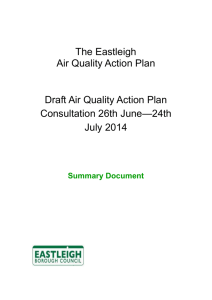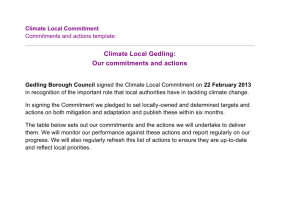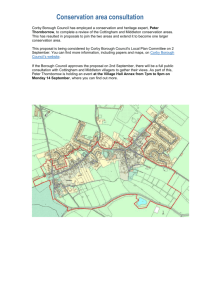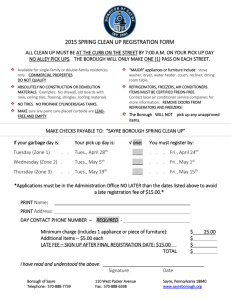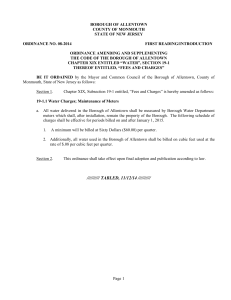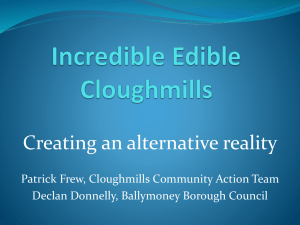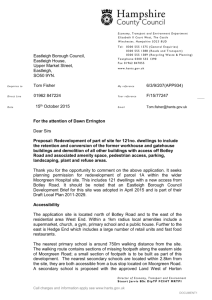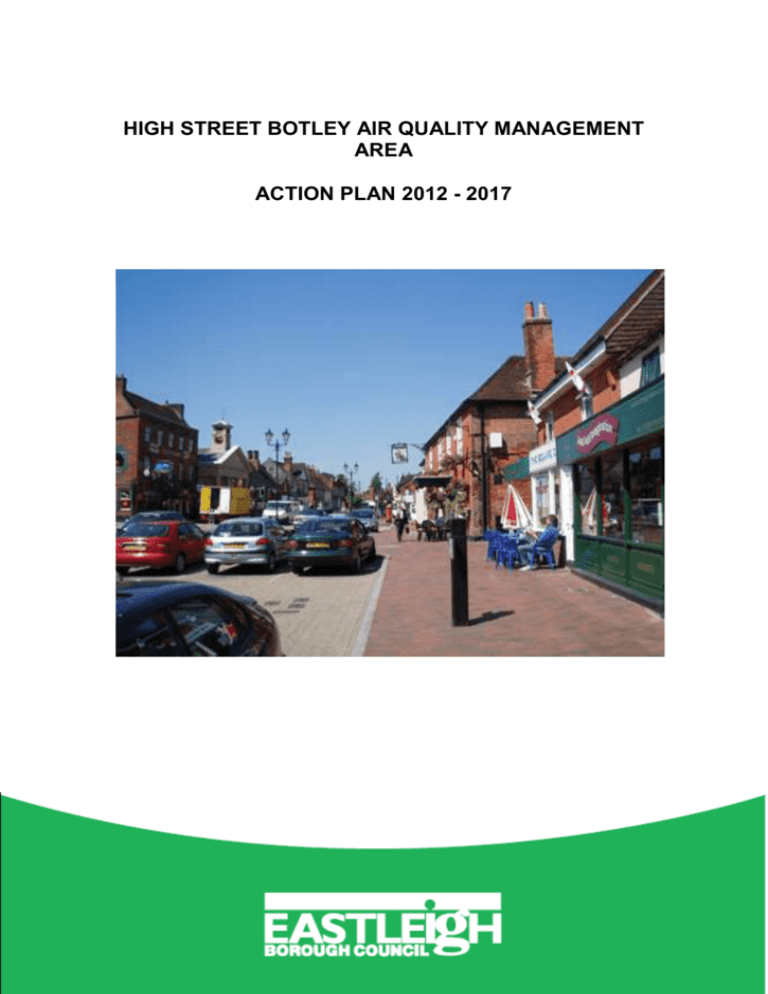
HIGH STREET BOTLEY AIR QUALITY MANAGEMENT
AREA
ACTION PLAN 2012 - 2017
EXECUTIVE SUMMARY
Eastleigh Borough Council, Environmental Health has prepared this report as
part of its duties under the Environment Act 1995. Monitoring of levels of the
pollutant nitrogen dioxide has shown that the annual mean objective, set by
DEFRA, would not be met by its target date of the end of 2010 in the area of
the High Street, Botley due to traffic emissions.
The report sets out information on the types of vehicles using the High Street
within the declared Air Quality Management Area (AQMA) and the
contribution these make before moving on to listing the Actions to improve the
air quality, and giving further details about their impacts including non air
quality impacts such as noise.
The Actions are primarily transport based and include workplace and school
travel planning, vehicle emission testing, improving public transport and
increasing public awareness of the air pollution problems facing this AQMA.
The Council consulted on a draft version of this Action Plan between February
2011 and November 2011. Consultees included other Council Departments,
Councillors, members of the Public, local businesses and other interested
parties.
INTRODUCTION
Background to the Local Air Quality Management Process
Eastleigh Borough Council (EBC) Environmental Health Service has
responsibility for implementing the air quality requirements of the Environment
Act 1995. As part of this responsibility the Environmental Health Service
undertakes monitoring of air quality within the Borough and regularly produces
reports on this data, (available on the Eastleigh Borough Council website).
The Environment Act 1995 Part IV requires Local Authorities to carry out a
‘Review and Assessment’ of local air quality. This includes monitoring and
modelling of air quality in the local area against objectives and target dates for
seven pollutants set out in the Air Quality Regulations 2000. These seven
pollutants are nitrogen dioxide, particulate matter, sulphur dioxide, carbon
monoxide, lead and 1,3-butadiene. If it is likely that any of the objectives will
not be met by the target date an ‘Air Quality Management Area’ (AQMA) must
be declared and a ‘five year Action Plan’ to improve air quality must then be
prepared.
Review and Assessment
To date Eastleigh Borough Council has completed the first, second and third
‘rounds’ of Review and Assessment and is currently working it’s way through
the fourth round. The first round was completed in 2000, the second in 2005
and the third in 2010. This involved assessing each of the seven pollutants to
determine whether the objectives were likely to be met by their target dates.
The conclusion of the first round was that all of the objectives for all pollutants
would be met by their target dates. Therefore no Air Quality Management
Areas were required.
The first stage of the second round of Review and Assessment was
completed in July 2007; this was known as an Updating and Screening
Assessment (USA). The USA included new monitoring and simple modelling
data gathered since the completion of the first round. Again this data was
used to determine whether the objectives for each of the seven pollutants
would be met. The USA concluded that further work would be required to
determine whether the nitrogen dioxide annual mean objective would be met
in certain areas.
A Detailed Assessment was completed in September 2010. This assessment
focused on certain areas of the Borough where the nitrogen dioxide annual
mean objective was likely to be exceeded. Complex modelling and monitoring
data was used in order to make this assessment and it was determined that it
was likely that the objective for Nitrogen Dioxide would not be met in The
High Street, Botley.
We were therefore required by DEFRA to declare an ‘Air Quality Management
Area’ (AQMA) to cover the area of the High Street from its junction with
Winchester Road to the Woodhouse Lane roundabout.
The Eastleigh Borough Council Area
Eastleigh Borough Council’s administrative area stretches from Chandlers
Ford in the north of the Borough to Hamble-Le-Rice in the south of the
Borough. It also includes Bishopstoke, Fair Oak, West End, Hedge End,
Botley, Bursledon and Netley, with the main town and administrative centre
being Eastleigh. The Borough of Eastleigh lies to the north and east of
Southampton, and has borders with Southampton City Council, Winchester
City Council, Test Valley Borough Council and Fareham Borough Council.
Background to the Air Quality Problems
There are two major motorways which pass through the Borough and meet in
Eastleigh. The motorways have a major impact on the traffic flows in the
Borough. The presence of the motorways along with the close proximity of
Southampton, and its docks, and Portsmouth (with ferry services to the
continent) means that many businesses are attracted to Eastleigh.
Specifically, the High Street in Botley is used as a means of avoiding
problems that occur on the motorways and is used by a higher than would be
expected number of HGV’s. The road itself is narrow in parts, which means
there is poor dispersal of air pollution. There are several pedestrian crossings
which means that the traffic flow is disrupted leading to queuing traffic which
in turn leads increased car emissions.
Figure 1 : High Street, Botley and road links
Crown Copyright. All rights reserved. Eastleigh Borough Council LA077860 (2006)
The next stage in the LAQM process was to carry out a ‘Further Detailed
Assessment’ of air quality within the AQMA. The Detailed Assessment
includes modelling work and supplements the information already held by the
Council on air quality within the AQMA and includes source apportionment to
enable the Council to establish the main source of the exceedence in order to
better target resources during the action planning process.
Detailed Assessment Modelling
The modelled contour plots for the area, around the High Street in Botley are
presented in Figure 2. The plot shows that there is an area of exceedence of
the target level around the junction with Winchester Street and also
approximately 100 metres west on the High Street, which is due to queuing
traffic at the pedestrian crossing. This shows that there is potential for
exceedence at Number 1-2 High Street, east of the junction and for many
properties located on the south side of the road, which are very close to the
kerbside, meaning there is little opportunity for the dispersal of the air
pollution.
Figure 2.
Crown Copyright. All rights reserved. Eastleigh Borough Council LA077860 (2006)
The map (figure 3) shows the boundaries of the Air Quality Management
Area. It stretches from the Woodhouse Lane roundabout to just east of the
Winchester Road junction with the High Street, and 10 metres either side of
the centre of the road.
Figure 3 : The High Street, Botley Air Quality Management Area
Crown Copyright. All rights reserved. Eastleigh Borough Council LA077860 (2006)
Air Quality Action Plan
The Action Planning stage is the most important part of the air quality
management process and provides the Council with the opportunity to
implement actions which can improve air quality. Most actions will be carried
out locally, either by Eastleigh Borough Council or Hampshire County Council
(HCC), the High Street is a HCC controlled road and therefore any works
required must be approved or implemented by them.
Aims of the Air Quality Action Plan
The principle aim of the Action Plan is to establish local measures to
improve air quality in and around the AQMA. These measures are
considered on the grounds of their air quality/pollution improvement,
impacts on noise, climate change etc, cost effectiveness and feasibility.
Other aims include:
To calculate how much each source (cars, HDV’s, other) contributes to
the exceedence of the nitrogen dioxide annual mean objective (known
as source apportionment).
Establish the improvements required in order to meet the objective.
Quantify the impacts of each of the measures both in terms of air
quality and other impacts such as noise.
Strategies, Policies and Guidance.
Eastleigh Borough Council Corporate Strategy
The Councils ‘Corporate Strategy’ sets out the aims and key priorities for the
Borough and the actions to achieve them. The strategy is driven by the
following purpose
“Our Purpose: The Council exists to improve the quality of life for all local
people”
As part of the strategy one of the key priorities for the Council is the
environment and on this subject the strategy states:
“We will protect and improve the Borough for the benefit of local people, now
and in the future.”
This Air Quality Action Plan and other air quality work carried out by the
Council therefore helps towards meeting the environment priority and the
strategy as a whole.
One of the Councils ‘Strategic Priorities’ is “Transportation: promoting more
sustainable transport systems, and minimising the adverse effects of
vehicles.”
Planning Policy and the EBC Local Plan
The Council currently has a policy on air quality assessments as part of the
Local Plan 2001-2011. The policy states:
Local Air Quality Management
The Council has an on-going duty to review and assess local air quality.
Where a statutory air quality objective is likely to be exceeded then an Air
Quality Management Area must be declared and an action plan developed to
improve air quality. Within the Borough the main source of poor air quality is
road traffic.
Air quality considerations will be taken into account in any of the following
cases:
Where the development is proposed within , or adjacent to, an AQMA
Where the development or the associated traffic, could result in the
designation of an AQMA
Where the granting of planning permission would conflict with, or
render unworkable, elements of any local air quality action plan or
strategy, and;
Where it is expected that the development may have a substantial
impact on the local air quality or future occupiers of the development
may be subject to unacceptable air quality then the Council may
require a suitable air quality impact assessment to be carried out prior
to consideration of the application.
Hampshire Local Transport Plan 2011-2031 (LTP3)
This is written in two parts:
A 20-year Strategy, which sets out a long-term vision for how the transport
network of Hampshire will be developed over the next 20 years, and
three-year Implementation Plan setting out planned expenditure on transport
over the period April 2011 to March 2014.
The Plan builds on the successes of previous local transport plans and look to
make improvements to the transport system which will benefit people living
and working in Hampshire. It has been produced following extensive
consultation with the public and our strategic partners.
The long term strategy is broken down to look at local area strategies and the
policy for South Hampshire is contained within Chapter 7: Policy E.
The following is an extract from the Hampshire County Council website
explaining the objectives of the LTP3:
‘The main objectives of the LTP3 are:
To increase accessibility
To promote safety
To reduce the impact and effect of congestion
To widen travel choice
To improve air quality
To support wider quality of life objectives
To encourage value for money and efficient asset management’
These objectives are to be achieved by a balanced strategy that seeks to
meet all the needs of all residents. The strategy includes measures to tackle
existing and future problems. It aims to improve all modes of transport to
provide a wider choice for the public. It balances the need to protect the
environment with the need for mobility.’
The long term strategy of the LTP3 is to:
Reduce the number of journeys made and the average length of
journeys, where this does not have disproportionate effects on quality
of life or the economy
Manage the existing transport networks effectively, to make the best
use of existing capacity
Invest in additional capacity, where there is shown to be essential
Overall emphasis will be given to investing in public transport networks,
particularly those catering for shorter journeys.
The LTP3 is available at: http://www3.hants.gov.uk/transport/local-transportplan.htm
Air Pollution: Traffic Emissions and Nitrogen Dioxide
Oxides of nitrogen (NOx) are found naturally in the atmosphere; natural
sources include lightning, forest fires, bacterial activity in the soil and plant
metabolism. Non-natural sources are produced through the reaction of
nitrogen and oxygen during combustion processes. The majority of nonnatural sources arise from road vehicle emissions (around 1 million tonnes
per annum – EPAQS, 1996), and power stations as well as other combustion
sources e.g. aircraft, trains. In Eastleigh Borough the main source of
nitrogen dioxide is from road vehicles.
The chemistry of air pollution is complex. The following is a simplified
description of the process of the formation of nitrogen dioxide (NO 2). Nitric
oxide (NO) is the gas emitted to the atmosphere by the above sources. In the
presence of oxygen (O) and under the right conditions nitric oxide and oxygen
combine to form nitrogen dioxide.
Cold, clear winter days can often lead to ‘inversions’. Inversions occur when
a layer (or lid) of cold air is trapped by warmer air above, this tends to occur
after clear cloudless nights when there is an early morning frost. Pollutants
are then trapped and can build up to high levels and smog may also occur.
Inversions are a fairly common occurrence in Eastleigh Borough due to its
location in a basin and unusually high levels of nitrogen dioxide can
occasionally be monitored on these cold, clear winter days.
Health Effects of Nitrogen Dioxide
The Expert Panel on Air Quality Standards (EPAQS) have studied the effects
of nitrogen dioxide on human health and have raised concerns about
exposure to nitrogen dioxide at lower levels, such as those found in towns and
cities. It is thought that this type of exposure may have acute short-term and
chronic long-term effects on health. Sensitive individuals such as those
suffering heart and lung diseases, including asthma are likely to be the first to
notice the effects of moderate pollution levels. At high levels those who are
not sensitive may notice the effects of pollution such as eye irritation.
The air quality standards in Figure 2, have been set for nitrogen dioxide,
based on evidence of its effect on health:
Figure 2: Nitrogen Dioxide Objectives
Pollutant
Air Quality Objective
Concentration
Measured as
3
Nitrogen dioxide
Annual mean
40g/m
3
(NO2)
Hourly mean
200g/m not to
be exceeded more
than 18 times a
year
Date to be
achieved by
31/12/2010
31/12/2010
Objectives are assessed in areas where there are ‘sensitive receptors’.
Sensitive receptors are residential areas, schools, hospitals etc, but do not
include workplaces. As described above the annual mean objective for
nitrogen dioxide may not be met by the target date in a number of areas within
the Borough. These are largely residential areas. It is not anticipated that
there will be any exceedence of the hourly mean objective.
Monitoring of Nitrogen Dioxide
The graph presented below shows the trends in nitrogen dioxide levels within
the High Street AQMA from 2008 to 2010. As can be seen from the graph,
levels of nitrogen dioxide on the High Street have been continually above the
objective (40ug/m3) over this time.
The Air Quality Actions
As previously stated in the introduction to this Action Plan the principal aim is:
“To establish local measures to improve air quality in the Air Quality
Management Area. These measures will be considered on the grounds
of cost effectiveness and feasibility.”
The main measures of the Action Plan are to:
Provide information and awareness
Consideration of alternative means of transport
Road network management
Management of road traffic emissions
Planning considerations
To better understand and help form the action plan, a public consultation took
place in 2011. A leaflet was distributed to properties in and around the
surrounding area of the AQMA. The consultation outlined the main air quality
problems and proposed measures aimed at addressing these and sought
public opinions on them and others that they may be able to suggest. We
received a total of 63 responses to this and a summary of them is given as
follows.
Number in support of
24
21
17
14
13
13
12
9
8
8
7
4
4
4
3
2
2
Measure / action
Botley by-pass
Alternative HGV route/ban
Detailed traffic analysis
Speed reduction / monitor
Improve pedestrian route
Work with local businesses
HGV weight restriction
AQ monitoring
Improve public transport
Improve traffic flow
Improve cycle network
School travel planning
HGV ‘L’ training
Re-site Vehicle testing
Deal with school parking
Daily deliveries to shops
Traffic calming measures
Likely AQ impact
Large
Large
N/A
Small
Small
Small
Medium
N/A
Small
Medium
Small
Medium
Medium
Medium
Small
Small
Overall, the results of the consultation process indicated general support for
the majority of the proposed action plan measures, with the highest
percentage of agreement being for a Botley By-Pass. It was also noted that
there was an overall concern about the number of HGV’s moving through the
High Street.
The ‘Air Quality Actions’ are presented over the following pages. The majority
of actions suggested will not have a major impact on air quality in their own
right, as shown in the table above, but will contribute towards an overall
improvement. Many of these ‘softer’ actions are based on the Department for
Transport ‘Smarter Choices’.
Most of the actions are transport based and many are projects which the
Council already has underway or was in the planning stages of. Others are
more aspirational, but by being included in the Action Plan can be elevated to
a level where they will hopefully be implemented in the future. There are no
problems related to industrial emissions and therefore the actions focus on
improving transport infrastructure and encouraging residents and businesses
to make use of the excellent public transport facilities, car share, walk or
cycle.
The actions are presented in the form of a table with some information on the
actions following. However, many of the actions will have a fairly small impact
in their own right and ranking them is therefore particularly difficult.
Actions to Improve Air Quality
Action are not ranked in any particular order
Action
Botley by-pass
Alternative HGV route/ban
Detailed traffic analysis
Speed reduction / monitor
Improve pedestrian route
Work with local businesses
HGV weight restriction
Real Time AQ monitoring
Improve public transport
Improve traffic flow
Improve cycle network
School travel planning
HGV ‘L’ training re-routing
Re-site Vehicle testing
School travel planning and parking
Traffic calming measures
Discussion of the Action Plan Measures
Further information on the aims of and reasons of the actions is given below.
A Botley By-Pass
The High Street in Botley is not a road that was designed for either the
numbers or types of vehicles that are currently using it. A new by-pass would
relieve traffic congestion therefore improving traffic flow and reduce the
vehicle numbers using the High Street. It would also potentially reduce travel
time and transportation costs for business and commerce.
The existing local plan for the area, the Eastleigh Borough Local Plan Review
2001 – 2011, includes a long standing proposal for a Botley bypass. Eastleigh
Borough Council is currently preparing their new Local Plan, the Eastleigh
Borough Council Local Plan 2011-2029, which includes a proposal for a
significant major housing development within the area. This would contribute
additional traffic to an already congested route. We are also aware that a
neighbouring Authority is reviewing their Local Plan, which may lead to
significant development which may also affect this road corridor, including the
potential for growth in traffic volumes related to the Whiteley housing
proposals.
The new Local Plan also carries forward the Botley Bypass proposal. This one
measure has the potential to improve air quality to such a degree that it could
bring the annual mean of air pollution down below the DEFRA objective.
Alternative HGV Route/Ban
There is a recognised issue with the amount of HGV movements through the
AQMA, having a disproportionate impact on air quality. Any alternative
route/restriction/ weight restriction needs to be explored with the County
Council and the Highways Agency. The road also has a wide load
designation. In addition voluntary agreements could be sought with local
businesses to encourage alternative routes away from the AQMA or to restrict
their drivers to times away from the peak hours. A 7.5 tonne lorry ban area
would aim to balance the importance of goods access to local businesses with
the environmental concerns of local residents.
Detailed Traffic Analysis
A detailed traffic analysis is required to inform of the numbers ant types of
vehicles passing through the AQMA. If done correctly and in the right areas it
will also give us a picture of where the vehicles are travelling to and from.
This will be valuable information for us to help inform and target actions.
Speed Reduction
By having a more constant lower speed this will aid the traffic flow and in turn
aid the amount and dispersal of air pollution. It will also reduce the potential
for accidents and injury, especially as the pedestrian route is very narrow in
parts. Speed enforcement is a matter for the Police whereas speed
restrictions are a matter for the Highways Authority.
Improved Pedestrian Route
The aim is to improve the pedestrian environment and promote the benefits of
walking to encourage more people to walk for short utility journeys and for
recreation, and to increase social interaction. The pedestrian routes either
side of the High Street and Broad Oak are very narrow in parts and need
continual maintenance to ensure there is no encroachment from trees/bushes.
The Highways Authority are currently developing plans to improve pedestrian
safety on Broad Oak. A successful “park and walk” scheme was introduced in
2010 across the Botley recreation ground in partnership with Botley Parish
council.
Work with Local Businesses
Encourage the use of work travel plans or fleet management plans. The plans
can cover a single business or a cluster of them working together. These can
help to reduce the traffic impacts of their activities. They look to reduce work
related car trips through initiatives such as car sharing, providing pool cars,
cycling incentives, cycle parking, showers and changing facilities. Travel plans
have been shown to have positive economic impacts for the organisation.
Servicing and deliveries to local businesses can cause problems. Traffic
congestion, lack of kerbside space, lack of rear servicing and difficulties in
manoeuvring can frustrate deliveries.
Increase Air Quality Monitoring
By continuing to monitor air quality we can better understand the areas that
are more affected. The greater the amount of data we can collect then the
better this can be used to give improved modelling results for the AQMA.
Improve Public Transport
Botley is served by four bus companies (Black Velvet, Bluestar, Brijan and
First Bus) for travel to local major towns including Eastleigh and
Southampton. Increased bus travel can prevent congestion, giving more
effective use of road space and help reduce air pollution. The availability of
affordable, reliable, convenient and safe public transport services is important
if people are to use it as a viable alternative to owning and using a car and
encourages greater social interaction. Therefore, although the Council is not a
direct provider of services, we should be firmly committed to supporting
measures to improve quality, reliability and accessibility.
Improve Cycle Network
Promotion of cycling has the benefit of lowering car journeys whilst helping
the healthiness of the cyclist. The Cycling Strategy is within the Hampshire
County Council LTP and is working towards a joined up network of cycle
routes. Parts of the northern part of Broad Oak have been identified as new
cycle routes. We should also look to increase the provision of secure cycle
parking facilities, have advanced cycle stop lines at signalised crossings.The
Highway authority are currently developing plans to extend cycle facilities on
Broad Oak.
School Travel Planning and Safer Routes to School
Continue to encourage the already well-established school travel plans to be
followed with the use of more sustainable forms of travel and through safer
routes for walking and cycling.
Benefit parents by reducing their commitment to delivering their children to
and from school
Benefit children by giving them a degree of independence and an opportunity
to take gentle exercise
Benefits the local community by reducing traffic and parking congestion
outside schools
Promotes the health and overall well-being of school children.
Fosters more neighbourly interaction and support for the school.
HGV Learning Re-routing
There is an HGV driver training centre and associated MOT centre within 3
miles of the High Street. Currently lessons in these HGV’s are often taken
up/down the High Street.
Opportunity to re-route the lessons away from this congested route or to relocate the test centre.
Contingency Planning
Effective contingency planning to minimise traffic disruption. Work with the
HCC and Highways Agency to influence tactical diversion routes in
emergencies away from the High Street.
Traffic Calming Measures
Traffic calming and traffic management schemes help to improve air quality by
promoting walking and cycling, by protecting access roads from the through
traffic and by providing opportunities for other environmental improvements
such as tree planting.
Sustainable Development
The assessment of planning applications in order to secure improvements in
air quality through mitigation with emphasis on sustainable development and
through contributions from planning contributions or conditions can in the long
term make a step forward in preventing air quality deterioration.
Air Quality and Travel Awareness Campaign
To raise the awareness of the local air pollution levels and issues, and the
environmental, economic and social effects of travelling by foot, bike and
public transport. To encourage socially responsible car share/use. Signs to
show that you are entering an AQMA.
Strategic Measures
Improve links with Local Transport Strategy/Area Action Plan.
Improve air quality links with Local Planning and Development Framework.
Integrate air quality with other Council strategies
Overall care must be taken with all of these actions to make sure that they do
not lead to social or economic exclusion, that they do not have knock-on
effects on local industry or employment, and that they do not simply shift the
problem elsewhere. However by a careful combination of a number of these
actions, overtime, the overall net ‘cost’ can be minimised; such combinations
are also likely to be more effective than simply relying on just one or two
actions.

